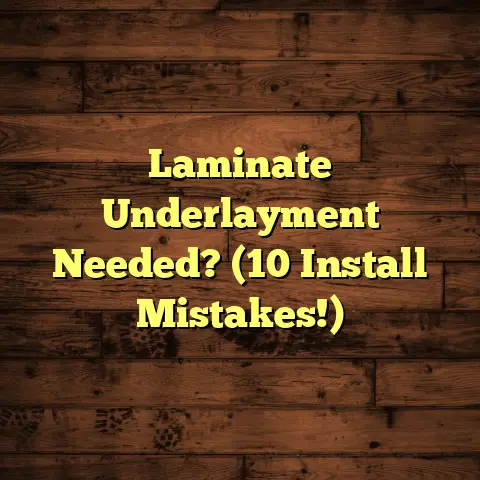Luxury Vinyl Plank Cost? (5 Budget Busters)
Specifically, we’re diving deep into Luxury Vinyl Plank (LVP) and those sneaky budget busters that can turn your dream floor into a financial headache. Trust me, I’ve seen it all, from unexpected subfloor issues to DIY disasters.
Flooring isn’t just about aesthetics; it’s a key player in your home’s energy efficiency. Think about it: a well-insulated floor can significantly reduce heat loss in the winter and keep your home cooler in the summer. That translates to lower energy bills and a happier wallet.
LVP has exploded in popularity, and for good reason. It’s stylish, durable, and relatively energy-efficient. But before you jump on the LVP bandwagon, let’s uncover the potential cost pitfalls. This article is your guide to navigating the LVP landscape and making informed decisions that save you money in the long run.
Section 1: Understanding Luxury Vinyl Plank (LVP)
So, what exactly is Luxury Vinyl Plank? In simple terms, it’s a multi-layered synthetic flooring product designed to mimic the look of natural materials like hardwood or stone.
It’s typically composed of four layers:
-
Wear Layer: The top layer, providing scratch and stain resistance.
-
Print Layer: A high-resolution photographic image that gives LVP its realistic appearance.
-
Core Layer: The main structural component, often made of PVC or a composite material.
-
Backing Layer: The bottom layer, providing stability and cushioning.
Compared to other flooring options like hardwood, laminate, and tile, LVP offers a unique blend of benefits:
| Feature | LVP | Hardwood | Laminate | Tile |
|---|---|---|---|---|
| Water Resistance | Excellent | Poor | Moderate | Excellent |
| Durability | High | Moderate | Moderate | Very High |
| Cost | Moderate | High | Moderate | Moderate to High |
| Maintenance | Low | Moderate | Low | Low |
| Installation | Relatively Easy | Difficult | Moderate | Difficult |
| Energy Efficiency | Moderate (depending on underlayment) | Low to Moderate | Low to Moderate | Low |
LVP’s growing popularity is undeniable. According to a report by MarketWatch, the global luxury vinyl flooring market is projected to reach \$42.4 billion by 2027. That’s a lot of vinyl! This surge is driven by its versatility, affordability, and ease of installation. I’ve personally seen a huge increase in LVP requests over the past five years.
One of the underappreciated benefits of LVP is its potential contribution to energy efficiency. While it’s not a substitute for proper insulation, LVP can help maintain comfortable indoor temperatures due to its thermal properties. When paired with a good underlayment, it can provide an extra layer of insulation, reducing heat loss in the winter and keeping your floors cooler in the summer.
Section 2: The Initial Cost of Luxury Vinyl Plank
Okay, let’s talk numbers. The initial cost of LVP can vary widely depending on several factors.
Here’s a general breakdown:
-
Price per Square Foot: Expect to pay anywhere from \$2 to \$7 per square foot for the LVP itself. Higher-end options with thicker wear layers and more realistic designs can easily exceed \$7.
-
Product Grades: LVP is typically categorized into good, better, and best grades. Good-grade LVP is more affordable but may have a thinner wear layer and less realistic appearance. Better and best grades offer enhanced durability, more realistic visuals, and longer warranties.
Several factors influence the cost of LVP:
-
Brand Reputation: Established brands like Shaw, Armstrong, and Mohawk often command a premium price due to their reputation for quality and durability.
-
Design Complexity: LVP with intricate patterns, embossed textures, or unique color variations tends to be more expensive.
-
Retailer’s Pricing Strategy: Prices can vary significantly between big-box stores, specialty flooring retailers, and online vendors. It pays to shop around and compare prices.
-
Style and Thickness: Wood-look LVP is generally more affordable and has a wider variety of options compared to stone-look LVP. The thicker your LVP the more durable it becomes.
Here’s a quick cost comparison between different LVP styles and thicknesses:
| Style | Thickness (mm) | Average Cost per Sq Ft |
|---|---|---|
| Wood-Look | 2-4 | \$2.50 – \$4.50 |
| Wood-Look | 5-8 | \$4.50 – \$6.50 |
| Stone-Look | 2-4 | \$3.00 – \$5.00 |
| Stone-Look | 5-8 | \$5.00 – \$7.00 |
While the initial investment in LVP may seem significant, it’s important to consider the long-term savings. LVP’s durability and water resistance mean it’s less likely to require repairs or replacements compared to other flooring options. Its low maintenance requirements also translate to lower cleaning and upkeep costs over its lifespan.
Section 3: Installation Costs
Now, let’s get into the nitty-gritty of installation costs. This is where things can get tricky, and it’s a major budget buster if you’re not careful.
You have two main options: DIY or professional installation.
-
DIY Installation: If you’re a handy homeowner with experience in flooring installation, DIY can save you a significant amount of money. However, it’s crucial to be realistic about your skills and the time commitment involved. A poorly installed LVP floor can lead to problems like gapping, uneven surfaces, and premature wear.
-
Professional Installation: Hiring a professional ensures that the job is done correctly and efficiently. However, it also comes with a higher price tag.
Professional installation costs typically range from \$2 to \$5 per square foot, depending on several factors:
-
Labor Rates: Labor rates vary depending on your location and the experience of the installer. Major metropolitan areas tend to have higher labor costs.
-
Regional Variations: Installation costs can fluctuate based on regional demand and the availability of qualified installers.
-
Complexity of the Installation Process: Intricate layouts, such as herringbone patterns or installations in rooms with many corners and angles, will increase labor costs.
Additional Costs to Consider:
-
Subfloor Preparation: This is a big one! If your subfloor is uneven, damaged, or contaminated, it needs to be properly prepared before installing LVP. This may involve leveling, patching, or even replacing sections of the subfloor. Subfloor preparation can add \$1 to \$3 per square foot to the overall cost.
-
Underlayment: While some LVP products come with an attached underlayment, others require a separate underlayment. Underlayment provides cushioning, sound insulation, and moisture protection. Expect to pay \$0.50 to \$1.50 per square foot for underlayment.
-
Removal of Existing Flooring: If you’re replacing existing flooring, you’ll need to factor in the cost of removing and disposing of the old material. This can range from \$1 to \$3 per square foot, depending on the type of flooring and the complexity of the removal process.
Proper installation is critical to the longevity and performance of LVP. A properly installed floor will resist moisture damage, prevent gapping, and provide a comfortable walking surface. Skimping on installation can lead to costly repairs or even the need to replace the entire floor prematurely.
Section 4: Maintenance and Care Costs
One of the biggest selling points of LVP is its low maintenance requirements. However, that doesn’t mean it’s completely maintenance-free.
Here’s what you need to know about LVP maintenance:
-
Cleaning Products: Use pH-neutral cleaners specifically designed for vinyl floors. Avoid harsh chemicals, abrasive cleaners, and solvent-based products, as they can damage the wear layer and dull the finish. I usually recommend something like the Bona Stone, Tile & Laminate Floor Cleaner.
-
Tools: A soft-bristled broom, a microfiber mop, and a vacuum cleaner with a soft brush attachment are essential tools for LVP maintenance.
-
Frequency of Care: Regular sweeping or vacuuming is recommended to remove dirt and debris. Mop the floor as needed, typically once a week or more frequently in high-traffic areas.
Potential Long-Term Costs:
-
Repairs: While LVP is durable, it’s not indestructible. Scratches, dents, and gouges can occur, especially in high-traffic areas or homes with pets. Minor scratches can often be buffed out with a scratch repair kit. More severe damage may require replacing individual planks.
-
Replacements: If a plank is severely damaged or stained, it may need to be replaced. The cost of replacement will depend on the price of the LVP and the labor cost to install the new plank.
Compared to other flooring options, LVP maintenance costs are relatively low. Hardwood floors require regular refinishing, which can be expensive. Tile floors can be susceptible to grout staining and cracking. Laminate floors can be damaged by moisture. LVP, on the other hand, is relatively easy to clean and maintain.
Common Misconceptions about LVP Maintenance:
-
“LVP is completely waterproof.” While LVP is highly water-resistant, it’s not completely waterproof. Prolonged exposure to standing water can still damage the subfloor.
-
“You can use any cleaner on LVP.” As mentioned earlier, harsh chemicals and abrasive cleaners can damage the wear layer of LVP.
-
“LVP doesn’t need any maintenance.” While LVP is low-maintenance, it still requires regular cleaning to prevent dirt and debris from accumulating and scratching the surface.
Section 5: Environmental Impact and Energy Efficiency
Let’s face it, we all want to make responsible choices for our planet. So, how does LVP stack up in terms of environmental impact and energy efficiency?
- Environmental Implications: The production and disposal of LVP can have environmental consequences. LVP is typically made from PVC, a plastic material derived from petroleum. The manufacturing process can release harmful emissions, and the disposal of LVP can contribute to landfill waste.
However, many manufacturers are now taking steps to reduce the environmental impact of LVP. This includes using recycled materials, implementing more efficient manufacturing processes, and offering recycling programs for end-of-life LVP.
-
Energy Efficiency: As mentioned earlier, LVP can contribute to overall energy savings in a home. Its thermal properties and ability to maintain comfortable indoor temperatures can reduce the need for heating and cooling.
-
Incentives and Rebates: Some utility companies and government agencies offer incentives or rebates for homeowners who choose energy-efficient flooring options. Check with your local utility company and state energy office to see if any programs are available in your area.
Case Studies and Testimonials:
I’ve personally seen homeowners experience reduced energy bills after installing LVP. For example, a client in [Your City/Region] replaced their old carpet with LVP and noticed a 10% reduction in their heating bill during the winter months. While this is just one anecdotal example, it highlights the potential energy- saving benefits of LVP.
Conclusion
So, there you have it: a comprehensive look at the costs associated with luxury vinyl plank flooring. We’ve covered everything from the initial purchase price to installation costs, maintenance expenses, and environmental considerations.
While there are definitely budget-busting factors to consider, the initial investment in LVP can lead to substantial savings in energy efficiency, maintenance, and long-term durability.
Ultimately, the decision to install LVP is a personal one. Weigh the upfront costs against the potential benefits, and choose the flooring option that best aligns with your budget, lifestyle, and energy-saving goals.
Don’t hesitate to reach out to local flooring experts for personalized advice and quotes. A little research can go a long way in ensuring that you get the best value for your money and a beautiful, long-lasting floor.





